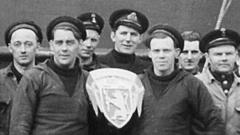In recognition of their vital role in supporting the Norwegian resistance against Nazi Germany, commemorative events and journeys recreate the remarkable history of these covert operations.
**The Legacy of the Shetland Bus: A Symbol of Resistance in WWII**

**The Legacy of the Shetland Bus: A Symbol of Resistance in WWII**
The heroic actions of the Shetland Bus convoys during World War II continue to inspire remembrance and resilience.
In the frigid winters of World War II, a clandestine operation known as the ‘Shetland Bus’ emerged as a significant lifeline for Norway’s resistance movement. Beginning in 1940, small fishing boats launched from Scotland’s Shetland Islands, braving treacherous waters to deliver covert supplies and agents to occupied Norway and return with refugees seeking asylum in Britain. This operation is now being honored with a historical voyage as part of the 80th Anniversary of Victory in Europe (VE) Day.
The historical continuum was sparked by Nazi Germany's invasion of Norway on April 8, 1940, which forced the Norwegian government, including King Haakon VII, into exile. Thousands fled to the UK aboard fishing vessels, spurring British Prime Minister Winston Churchill to establish the Special Operations Executive (SOE) dedicated to sabotage and espionage throughout German-controlled Europe. The Shetland Bus was a crucial component of this effort, enabling 200 North Sea crossings from 1940 to 1945, transporting hundreds of resistance operatives, tons of weaponry, and aiding in the rescue of over 300 Norwegian refugees.
The perilous journeys were undertaken in the darkest winter months to evade detection by German patrols, but this inherently posed severe risks. Crews faced harsh maritime conditions, and discovery by enemy boats or planes remained a constant threat. The M/K Arnefjord, for example, navigated a fierce storm on September 27, 1941, successfully delivering 20 refugees to Shetland despite the dangers; however, a total of 10 fishing boats would ultimately be lost in these convoys, resulting in the deaths of 44 men.
One of the last surviving vessels, the M/K Arnefjord, will once again make this arduous journey as part of the VE Day celebrations. Skipper Morten Neset confirmed that winter crossings were essential to minimize detection, emphasizing the operation's role in fostering hope and resistance among Norwegians against Nazi occupation. “The Shetland Bus was really important for the general population,” he stated, showing their desire for freedom and resilience.
The legacy of the Shetland Bus endures deeply, woven into the fabric of community resilience and international friendship. Today, memorials in locations like Scalloway pay homage to those who lost their lives while efforts by groups like the Shetland Bus Friendship Society highlight the historic connections formed during these turbulent times. As the Liberation Convoy sets sail from Bergen to Lerwick on May 6, it will not only retrace significant historical footsteps but also reinforce the enduring ties between Shetland and Norway, celebrating their shared narrative of courage amid adversity.
The historical continuum was sparked by Nazi Germany's invasion of Norway on April 8, 1940, which forced the Norwegian government, including King Haakon VII, into exile. Thousands fled to the UK aboard fishing vessels, spurring British Prime Minister Winston Churchill to establish the Special Operations Executive (SOE) dedicated to sabotage and espionage throughout German-controlled Europe. The Shetland Bus was a crucial component of this effort, enabling 200 North Sea crossings from 1940 to 1945, transporting hundreds of resistance operatives, tons of weaponry, and aiding in the rescue of over 300 Norwegian refugees.
The perilous journeys were undertaken in the darkest winter months to evade detection by German patrols, but this inherently posed severe risks. Crews faced harsh maritime conditions, and discovery by enemy boats or planes remained a constant threat. The M/K Arnefjord, for example, navigated a fierce storm on September 27, 1941, successfully delivering 20 refugees to Shetland despite the dangers; however, a total of 10 fishing boats would ultimately be lost in these convoys, resulting in the deaths of 44 men.
One of the last surviving vessels, the M/K Arnefjord, will once again make this arduous journey as part of the VE Day celebrations. Skipper Morten Neset confirmed that winter crossings were essential to minimize detection, emphasizing the operation's role in fostering hope and resistance among Norwegians against Nazi occupation. “The Shetland Bus was really important for the general population,” he stated, showing their desire for freedom and resilience.
The legacy of the Shetland Bus endures deeply, woven into the fabric of community resilience and international friendship. Today, memorials in locations like Scalloway pay homage to those who lost their lives while efforts by groups like the Shetland Bus Friendship Society highlight the historic connections formed during these turbulent times. As the Liberation Convoy sets sail from Bergen to Lerwick on May 6, it will not only retrace significant historical footsteps but also reinforce the enduring ties between Shetland and Norway, celebrating their shared narrative of courage amid adversity.


















